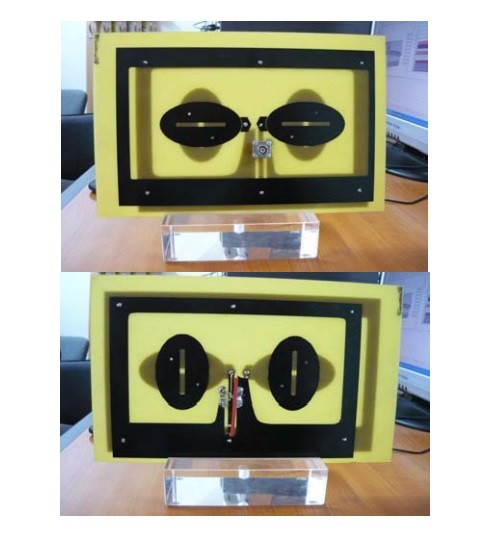
دانلود رایگان مقاله آنتن خط استریپ با دوقطبی های بیضوی

چکیده
این مقاله، جنبه های نطری و عملی اصلی را با در نظر گرفتن آنتن خط استریپ با دوقطبی های بیضوی ارائه می دهد. اصول طراحی آنتن خط استریپ، شکل آنها و ابعاد فیزیکی در اینجا ارائه می شوند. این مقاله، مشخصات خاص آنتن خط استریپ را با دوقطبی های بیضوی ترسیم می نماید. این مشخصات به طور آزمایشی بررسی می شوند.
1. مقدمه
در همین زمان ها، اهمین فزاینده سیستم های ارتباطی بی سیم و تلاش های فزاینده خدمات IT شخصی (فناوری های اطلاعات) (مثلاً بلوتوث) به طراحی و پیاده سازی ساختارهای میکرواستریپ جدید از مدارهای الکترونیکی مینیاتوری به آرایه های آنتن اختصاص داده شده اند. یک کاربرد مهم، طراحی آنتنهای میکرواستریپ است که نماینده های جذابی برای سیستم های تطبیقی در سیستم های ارتباطی کنونی و آینده هستند. مزایای عمده آنها، وزن سبکه، هزینه کم، نقشه تطبیق کننده با سطح یا صفحه ای، بهره خوب (بهره به دست آمده قابل مقایسه با آنتن های کلاسیک بزرگ است) و قابلیت انسجام با مداربندی پردازشی سیگنال یا الکترونیکی است (wong 1999).
از طرف دیگر، طراحی مدارهای مایکروویو غیرفعال/فعال نیاز به درک روابط ریاضی (یعنی تئوری) و کاربردها (یعنی شبیه سازی کامپیوتری و اندازه گیری ها) دارد.
روابط ریاضی تنها برای ساختارهای میکرواستریپ ایده آل سازی شده، ساده وجود دارد و می تواند تنها به درک اساس ها کمک نماید.
این مقاله به توصیف طراحی، معماری و ازمایش آنتن خط استریپ با دوقطبی های بیضوی می پردازد.
2. آنتن خط استریپ با دوقطبی های بیضوی
2.1. اصول طراحی
فرکانس تشدید انتخاب شده برای طراحی 900MHz است. طول موج حقیقی و نظری (Balanis 1997) برابرست با MHz900f ⇒ cm33 109 103 f c 8 8 th
اندازه ببیضی با استفاده از λth محاسبه می شود و برای محاسبه اندازه رزوناتور نوع شیار از λreal استفاده می شود.
برای محاسبه تقاطعات محور بیضی، در مورد هارمونیک های بالاتر، از روش درون یابی (Morariu, 2009; Evangelos, 2006:294-297) روی رزوناتور استوانه ای با تخمین مرزهای بیضوی استفاده شد (اشکال 1 و 2)
این روش شامل معادل نمودن سطوح تابشی معمول با دو دوقطبی خط استریپ جمع آثار شده و جدا شده توسط لایه دی الکتریکی همانند شکل 1 می شود، با یک ناحیه دایروی معادل که در شکل 2 ارائه شده است و از تابش انتقالی روی مرز بیضوی و صفحه دوقطبی پشت دی الکتریک صرفه نظر می شود (تاثیر انها مینیمم است)
با اعمال این روش، یک کاوک تشدیدکننده استوانه ای خط استریپ مانند شکل 3 به دست می آید که فرکانش تشدید آن با استفاده از محاشبه برای تغییر میدان الکترومغناطیسی فرکانس بالا بین صفحات خازن صفحه دایروی موازی با دی الکتریک نتیجه می شود.
Abstract
The paper presents the main theoretical and practical aspects regarding stripline antenna with elliptical dipoles. There are presented design principles of the stripline antenna, their shape and physical dimensions. The material outlines specific characteristics of the stripline antenna with elliptical dipoles. The characteristics are investigated experimentally.
1. INTRODUCTION
At the same time increasing importance of wireless communication systems and personnel IT (information technologies) services (e.g., Bluetooth) increasing efforts are devoted to the design and implementation of novel microstrip structures from miniaturized electronic circuits to the antenna arrays. One major application is design of microstrip antennas which are attractive candidates for adaptive systems in the present and future communication systems. Their main advantages are light weight, low cost, planar or conformal layout, good gain (the gain obtained are comparable with gain of big classical antennas), and ability of integration with electronic or signal processing circuitry (Wong, 1999).
On the other hand, designing active/passive microwave circuits requires understanding of both mathematical relations (i.e., the theory) and applications (i.e., computer simulations as well as measurements).
Mathematical relations exist for only simple, idealized microstrip structures and may help to understand only the fundamentals.
This article describes the design, architecture and testing of stripline antenna with elliptical dipoles.
2. THE STRIPLINE ANTENNA WITH ELLIPTICAL DIPOLES
2.1 Design Principles.
The resonant frequency selected for the design is 900 MHz. Theoretical and real wavelength is (Balanis, 1997): = MHz900f ⇒ cm33 109 103 f c 8 8 th = ⋅ ⋅ ==λ⇒ (1) cm5.20 61.1 33 r th real == ε λ
The size of the ellipse was calculated using λth, and to calculate the size of the slot type resonator was used λreal.
For the calculus of the ellipse axis intersections, in case of higher harmonics, it was used the interpolation method (Morariu, 2009; Evangelos, 2006:294-297) on the cylindrical resonator by approximation at the elliptical boundaries (figure 1 and figure 2).
The method consist in the equivalence of common radiating surfaces to those two stripline dipoles superimposed and separated by the dielectric layer as in figure 1, with an equivalent circular area presented in figure 2, neglecting the transfer radiation on the elliptical boundary and dipole plane behind the dielectric (their influence is minimal).
Applying this procedure it is obtain a stripline cylindrical resonant cavity like in Figure 3, whose resonance frequency is derived using the calculation for the variation of high frequency electromagnetic field between plates of the parallel circular plane capacitor with dielectric εr.
چکیده
1. مقدمه
2. آنتن خط استریپ با دوقطبی های بیضوی
2.1. اصول طراحی
2.2 معماری انتن.
2.3 نتایج آزمایشی.
4. نتیجه گیری
Abstract
1. INTRODUCTION
2. THE STRIPLINE ANTENNA WITH ELLIPTICAL DIPOLES
2.1 Design Principles
2.2 Antenna architecture
2.3 Experimental results
4. CONCLUSIONS
